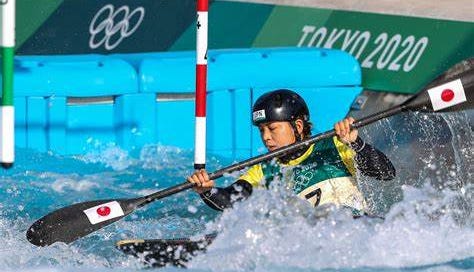Olympic Canoeing flies under the radar for most viewers, but it’s busier than you expect with 199 athletes competing in 16 events. The total number has actually shrunk in the past decade (it was 326 in 2016). The races fall into three groups, Canoe Sprint, Canoe Slalom, and the brand-new Kayak Cross.
The Basics
Both canoe and kayak races feature on the Olympic Games program, each with its own specific rules. Canoeists kneel in the boat and use a single-blade paddle on one side at a time, whereas kayakers are seated and use a double-bladed paddle.
Slalom races take place on an artificial white-water course. Competitors have to navigate boats through a course of gates (18 to 25) in the fastest time possible, taking care not to incur penalties for missing or touching gates. These races put athletes’ concentration, reactions and technique to the test.
Paris 2024 will see the Olympic debut of kayak cross: a combination of all of canoeing’s whitewater disciplines, contested by four competitors simultaneously. This is expected to make for some fun and chaotic moments.
Canoe sprint races take place on flatwater and feature sprints over various distances (women’s races are either over 200m or 500m, while men’s races are either 500m or 1000m), with one, two or four athletes per boat. This looks visually similar to Rowing, with everyone racing in their own lanes across the screen.
The Format
In every event, only 1 boat per country can compete. Spain has someone entered in 15/16 events, the most of any country. The Canoe & Kayak Slalom events start with between 17 and 22 athletes. They do 2 preliminary runs, with the best time kept. The top 15 move to the semifinal. Then they get just one semifinal run, with the top-ten advancing to the final. The final is also just one attempt at the course. The Kayak Cross events will feature 24 athletes. Since it’s brand new, not a ton of information is available about the format, but I can tell you there is a Time Trial, Round One, Heats, Repechage, Quarterfinal, Semifinal, and Final. There will be 4 athletes per heat.
There are 5 men’s and 5 women’s Canoe/Kayak Sprint events. The women compete in Canoe Singles (200m), Canoe Doubles (500m), Kayak Singles (500m), Kayak Doubles (500m), and Kayak Quads (500m). The men compete in Canoe Singles (1000m), Canoe Doubles (500m), Kayak Singles (1000m), Kayak Doubles (500m), and Kayak Quads (500m). All of these events start with 10 - 16 boats. A series of heats cuts the field down to 8 for the final.
What Countries are Historically Good?
Here is the medal table going back to 2008:
#1 Germany (12 gold, 7 silver, 11 bronze)
#2 Hungary (11 gold, 5 silver, 3 bronze)
#3 Great Britain (5 gold, 5 silver, 3 bronze)
#4 Spain (4 gold, 7 silver, 3 bronze)
#5 Slovakia (4 gold, 4 silver, 3 bronze)
#6 Australia (4 gold, 2 silver, 6 bronze)
Rounding out the top 10 is New Zealand, Ukraine, Czech Republic, and France.
Schedule
July 27th: M Canoe & W Kayak Slalom Heats
July 28th: Women’s Kayak Slalom Final
July 29th: Men’s Canoe Slalom Final
July 30th: W Canoe & M Kayak Slalom Heats
July 31st: Women’s Canoe Slalom Final
August 1st: Men’s Kayak Slalom Final
August 2nd: M/W Kayak Cross Time Trial
August 3rd: M/W Kayak Cross Heats
August 4th: M/W Kayak Cross Heats
August 5th: M/W Kayak Cross Final
August 6th: M/W Sprint Race Heats
August 7th: M/W Sprint Race Heats
August 8th: Men’s Canoe Double Final + Men’s & Women’s Kayak Quad Finals
August 9th: Men’s & Women’s Kayak Double Final + Women’s Canoe Double Final + Men’s Canoe Single Final
August 10th: Women’s Canoe Single Final + Men’s & Women’s Kayak Single Final



